Social Welfare
The Middle Class Story
Steady Progress and Supportive Governance
Posted On: 05 JUN 2025 9:50AM
Introduction
For over a decade, the middle class in India has found itself at the heart of the nation’s progress story. Their hopes, needs and aspirations have not just been heard but acted upon with purpose. From tax relief that leaves more money in their hands to pension schemes that promise security in old age, the last eleven years have seen a steady and sincere effort to make life easier, fairer and more dignified for millions.
The government has cut through red tape, simplified rules and made everyday systems work better. Be it filing taxes, buying a home, commuting to work or affording medicines, things have become simpler and more accessible. These are not scattered changes but a pattern of reforms that speak to the real concerns of ordinary citizens. What stands out is the consistency. Year after year, budget after budget, step after step, the government has stood by the middle class. In doing so, it has not only respected their hard work but also recognised them as key drivers of India’s growth.
Simpler Taxes and Assured Pensions
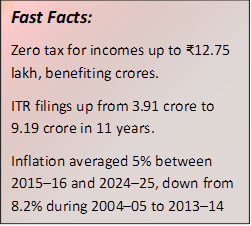
Over the past eleven years, the Government has gone beyond token measures to make a real difference in the lives of the middle class. From lowering income tax rates to simplifying returns, every move has been aligned with the core idea of letting citizens keep more of what they earn. The approach has been clear. Listen to citizens, simplify the system and deliver on promises.
The most recent tax reforms, especially those in the Union Budget 2025–26, are a clear sign that the Government has placed its trust in the middle class as a pillar of national growth. Whether it is raising the income threshold for zero tax, introducing a simplified tax regime or making return filing easier than ever, the effort has been constant and focused. What stands out is not just the scale of reforms but the sense of fairness and recognition they carry for honest, hardworking taxpayers.
Easier Income Tax Compliance
Over the past eleven years, income tax policy has steadily provided meaningful relief. The Government raised exemption limits, introduced standard deductions, launched a simplified tax regime in 2020, and reduced paperwork. These efforts have added up to make life easier for taxpayers.
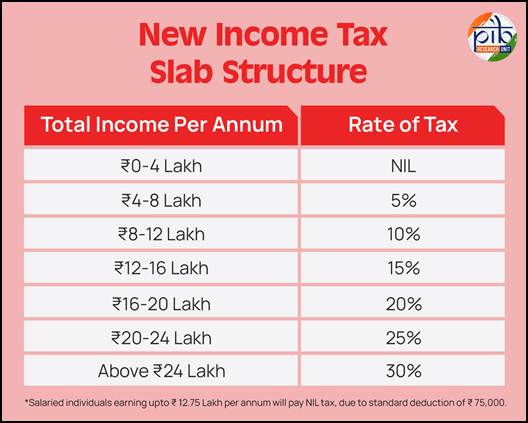
In the Union Budget 2025–26, another major change was announced. Individuals earning up to ₹12 lakh annually will now pay no income tax, except on special incomes like capital gains. With the standard deduction of ₹75,000, even those earning ₹12.75 lakh will pay no tax. The standard deduction reduces taxable income automatically by a fixed amount, easing the burden on salaried employees by lowering their overall tax liability without the need to claim multiple exemptions or submit detailed proofs. This reform will benefit crores of salaried citizens. It shows a deep understanding of middle-class needs and comes despite the Government giving up nearly ₹1 lakh crore in revenue.
Income Tax Return Simplification
To make tax compliance easier, individual taxpayers are now provided with pre-filled Income Tax Returns. These returns include details like salary income, bank interest, dividends, and more.
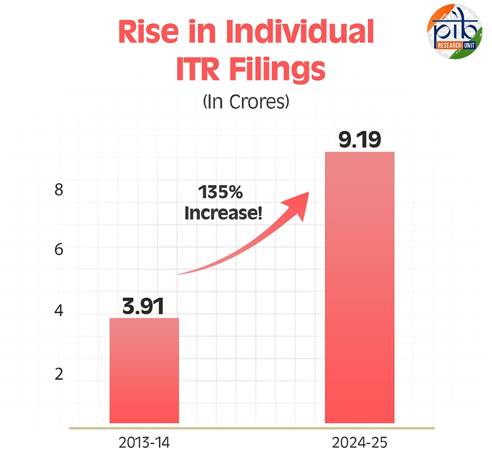
This ease is reflected in the rise of individual ITR filings, which increased from 3.91 crore in FY 2013–14 to 9.19 crore in FY 2024–25. This growth shows that more people find it simpler and worthwhile to comply with tax laws.
Faceless IT Return e-Assessment
Launched in 2019, the faceless e-assessment system changed how tax scrutiny works for individuals. It replaced face-to-face meetings with a fully digital and anonymous process, reducing scope for harassment and increasing trust.
The National e-Assessment Centre in Delhi is the single point of contact for taxpayers and assessment units. When an income return is selected, a notice under Section 143(2) is issued, and the taxpayer must respond within 15 days. The case is then assigned to an assessment unit through an automated system. The taxpayer does not know who is assessing the return or where it is being handled. This shift from territorial to dynamic jurisdiction ensures fairness and removes discretion.
For years leading up to 2014, rising prices kept middle-class families under constant strain. Between 2009–10 and 2013–14, inflation stayed in double digits. Essentials like food and fuel became increasingly costly. Household budgets were stretched, and saving felt out of reach. Looking over the decade from 2004–05 to 2013–14, the average annual inflation stood at a steep 8.2 percent. This prolonged period of price instability made everyday life harder and planning for the future uncertain.
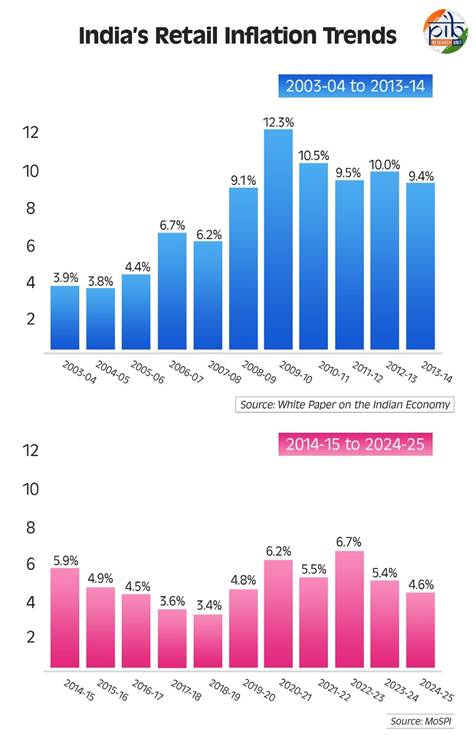
Things began to change from 2014. Over the next eleven years, inflation came under firm control. From 2015–16 to 2024–25, the average rate fell to just 5 percent. The difference is visible not only in the numbers but in daily life. Stable prices gave families breathing room. Essentials became more affordable, and planning monthly expenses became easier. This shift was the result of sound policy, strong coordination with the Reserve Bank, and better supply-side management. The middle class, long hit by rising prices, finally found relief and regained confidence in the economy.
In a major step to strengthen social security for government employees and their families, the Union Cabinet approved the Unified Pension Scheme (UPS) on August 24, 2024. The scheme ensures an assured pension of 50% of the average basic pay drawn during the last 12 months before retirement, applicable to employees with at least 25 years of service. For those with shorter service tenures, the pension will be calculated proportionately, with a minimum qualifying period of 10 years. A minimum assured pension of ₹10,000 per month will be provided upon retirement after completing 10 years of service. In case of the employee’s death, their family will receive a pension equal to 60% of the assured pension.
The Unified Pension Scheme came into effect from April 1, 2025, and it is expected to benefit around 23 lakh Central Government employees. Several State Governments have also adopted this model, extending its coverage to over 90 lakh individuals currently under the National Pension System.

Urban Growth and Connectivity
In the last eleven years, India’s urban landscape has undergone a remarkable shift. Affordable housing has reached those who needed it most. Cities have become more liveable with better roads, cleaner air, smarter public services and modern transport systems. For the middle class, this has brought dignity and convenience. These gains are the result of a long-term vision, consistent funding and effective execution. From first-time homebuyers to daily metro commuters, crores of citizens have felt the change in their homes, on their streets and throughout their neighbourhoods.
Launched on 25 June 2015, the Smart Cities Mission gave Indian cities a new life. It reimagined how people live, move, work and spend their time. By 2025, 93 percent of the 7545 approved projects were completed, with a total investment of over ₹1.51 lakh crore. Each of the 100 Smart Cities now runs an Integrated Command and Control Centre. These centres support better safety, traffic control, waste collection and water management.
Over 83,000 CCTV cameras, 1,884 emergency call boxes and 3,000 public address systems now help cities stay alert and responsive. More than 1,200 public space projects have brought back life to city parks, lakefronts and markets. Education has improved with 9,400 smart classrooms in 2,300 government schools and 41 new digital libraries. Health infrastructure got a push too with 3,100 hospital beds added and digital health records introduced in 15 cities.
On the housing front, 23 smart cities delivered 35,000 affordable homes. Water supply, solid waste and sewerage systems were upgraded using smart technology. Transport became smoother with 1,700 km of smart roads, 713 km of cycling lanes, 23,000 bicycles and over 1,500 buses added to public fleets. More than 50 cities turned to Public-Private Partnerships to deliver over 200 high-impact projects.
Pradhan Mantri Awas Yojana (Urban)
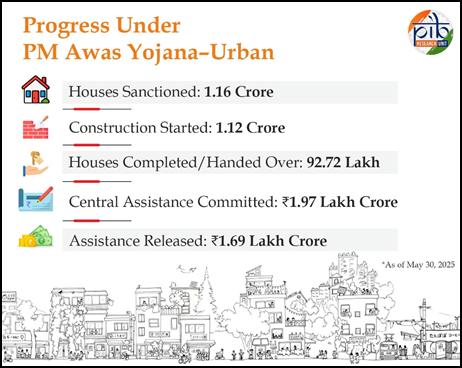
The Pradhan Mantri Awas Yojana (Urban) has become a strong symbol of hope for millions of middle-class and low-income families. Launched in 2015, the mission has steadily moved toward the goal of a safe and dignified home for every Indian. The scheme is more than just about building houses. It has brought pride, stability, and a sense of empowerment to families across cities. Its scale, reach, and focus on fairness make it one of the most impactful urban welfare schemes in independent India.
The Centre has committed ₹1.97 lakh crore in assistance. Of this, ₹1.69 lakh crore has already been released. From 2014 to 2025, as of May 19, over 1.16 crore houses were sanctioned. Construction has begun on more than 1.12 crore homes. Over 92.72 lakh houses have been completed or handed over. These are not just figures, they represent tangible stories of progress.
Urban transport saw its biggest boost in decades. Metro rail is now either running or being built in 29 cities. By May 2025, India had 1,013 km of metro lines in operation, up from just 248 km in 2014. That is an addition of 763 km in just eleven years. India now ranks third globally in terms of total metro rail network.
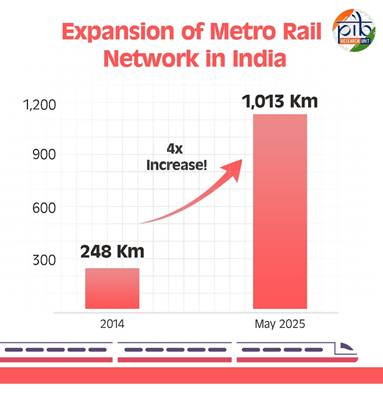
In this period, 34 metro projects spanning 992 km were approved. Daily ridership, which stood at 28 lakh in 2013 to 14, has now crossed 1.12 crore. The pace of commissioning new lines has grown nine times. On average, 6 km of metro lines are now operationalised every month, compared to just 0.68 km per month before 2014. The annual budget for metro rail has also increased more than six times, rising from ₹5,798 crore in 2013-14 to ₹34,807 crore in 2025-26.
The Ude Desh Ka Aam Nagrik (UDAN) scheme, launched on 21st October 2016, has made air travel affordable and accessible for the common citizen. In its sixth year, UDAN has connected 88 airports including 2 water aerodromes and 13 heliports through 625 routes. The first UDAN flight took off from Shimla to Delhi on 27th April 2017. Since then, over 1.49 crore passengers have benefited from low-cost regional air travel.
India’s airport network has grown from 74 airports in 2014 to 160 in 2025. ₹4,023.37 crore has been disbursed as Viability Gap Funding to support air connectivity in underserved regions. The scheme has boosted tourism, improved access to healthcare, and spurred trade in tier 2 and tier 3 cities, driving inclusive regional development.
To safeguard the interests of homebuyers and bring transparency to the housing sector, Parliament enacted the Real Estate (Regulation and Development) Act in 2016. It marked a key step toward accountability in real estate transactions. Under RERA, each state and union territory set up a regulatory authority tasked with maintaining a public portal that lists project details for registered developments.
As of March 17, 2025, over 1.4 lakh consumer complaints have been resolved by Real Estate Regulatory Authorities across India. This shows how the law has helped restore trust and ensure fair practices in the real estate market.
Healthcare Accessibility and Affordability

Healthcare in India has seen a quiet but far-reaching shift in the last eleven years. Through a blend of targeted public schemes and digital reach, the Government has made quality healthcare both affordable and accessible for millions, especially the middle class. From free hospitalisation for senior citizens to low-cost medicines available nationwide, people today have better control over their health expenses. The digital backbone supporting these schemes has made enrolment, access and tracking easier than ever. This change has allowed the middle class to benefit from savings on medicines, timely treatment, and greater medical security without bureaucratic hassles.
Ayushman Bharat: Expanding the Safety Net
The Ayushman Bharat–Pradhan Mantri Jan Arogya Yojana (AB-PMJAY) has emerged as one of the world’s largest publicly funded health assurance schemes. As of May 30, 2025, over 41.02 crore Ayushman Cards had been created in 33 States and Union Territories. The scheme has enabled 8.59 crore hospital admissions worth ₹1,19,858 crore, ensuring access to secondary and tertiary care without pushing families into debt.

A network of 31,958 empanelled hospitals adds to the convenience. On 29 October 2024, the scheme was extended to all senior citizens aged 70 years and above, regardless of income. This expansion marks a major step in easing the financial burden of healthcare for the elderly middle class.
Jan Aushadhi: Making Medicines Affordable

The Pradhan Mantri Bhartiya Janaushadhi Pariyojana (PMBJP) has brought essential medicines within reach of the common citizen. By May 30, 2025, the number of Jan Aushadhi Kendras had grown from just 80 in 2014 to 16,469. These outlets offer medicines that cost 50 to 80 percent less than branded options, with strict quality standards ensured through WHO-GMP certified suppliers.
The scheme serves around 10 to 12 lakh people daily, and cumulative savings over the last eleven years are estimated to be more than ₹38,000 crore. For the middle class managing chronic conditions like diabetes or heart disease, this has brought real and lasting relief. The product range now includes 2,110 medicines and 315 surgical products, covering all major treatments. For millions of families, especially the middle class, this scheme has meant less financial stress and more peace of mind.
Education and Skill Development
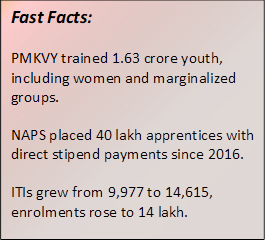
In the last eleven years, the Government has redefined the skilling and learning landscape for India’s aspiring middle class. With a clear focus on employability, inclusivity and industry alignment, a wide network of programmes has helped millions of Indians acquire job-ready skills. The Ministry of Skill Development and Entrepreneurship, set up in 2014, played a key role in this journey. What began as a response to a critical need has today become one of the largest human capital development efforts in the world. From short-term courses to apprenticeships, community learning to entrepreneurship, the Government’s approach has touched urban centres and rural households alike, offering opportunity, stability and hope.
Pradhan Mantri Kaushal Vikas Yojana (PMKVY)
Launched in 2015, PMKVY became the backbone of short-term skill training in India. As of April 18, 2025, it equipped over 1.63 crore youth with practical skills through certified training across sectors like manufacturing, healthcare, IT and construction. The scheme’s emphasis on inclusivity saw strong participation from women and marginalised communities. It also evolved with the times, introducing futuristic domains like Artificial Intelligence and Mechatronics. PMKVY ensured that skill training was not a privilege but a right, made available even in remote villages.
|
Total Candidates Trained under PMKVY
|
|
Scheme
|
Candidates Trained
|
|
PMKVY 1.0 (2015-16)
|
19,86,016
|
|
PMKVY 2.0 (2016-20)
|
1,10,00,816
|
|
PMKVY 3.0 (2020-22)
|
7,37,502
|
|
PMKVY 4.0 (2022-26)*
|
26,01,224
|
|
Total
|
1,63,25,558
|
Data as on 18th April 2025
* - PMKVY 4.0 is under implementation
National Apprenticeship Promotion Scheme (NAPS)
The revival of apprenticeships under NAPS made ‘learning while earning’ a reality for lakhs of young Indians. Over 40 lakh apprentices were placed with industries since 2016, with monthly stipends directly credited into their accounts. The scheme helped bridge the gap between classroom learning and workplace expectations. It also gave employers a steady stream of trained talent, strengthening India’s industrial base from the ground up.
Modernising the ITI Ecosystem
India’s Industrial Training Institutes have long been a pillar of vocational education. Over the past decade, these institutes saw a major expansion and upgrade. The number of ITIs rose from around 9,977 in 2014 to over 14,615 in 2024. This included the addition of 4,638 new institutes across the country, improving access to technical training in both rural and urban areas. Enrolments grew from 9.5 lakh to over 14 lakh during the same period, reflecting growing trust in vocational education among youth and their families.
In another major step to further strengthen vocational training, in May 2025, Government approved the National Scheme for Industrial Training Institute Upgradation and the setting up of five National Centres of Excellence for Skilling. This Centrally Sponsored Scheme will be implemented with a total outlay of ₹60,000 crore, including contributions from the Centre, States and industry.
Digital Governance and Convenience
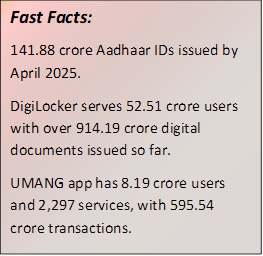
Over the past eleven years, digital governance in India has emerged as a strong pillar of middle-class empowerment. The Government’s focused push towards accessible, efficient and transparent digital services has reshaped how citizens interact with the State. From document access to service delivery, from financial inclusion to welfare access, digital tools have cut red tape, saved time, and brought convenience to homes across the country. The middle class, in particular, has benefited from faster services, fewer visits to offices, and reduced paperwork. Flagship initiatives like Aadhaar, DigiLocker and UMANG have not only made public services mobile and paperless but have also deepened trust in government systems.
Aadhaar: A Trusted Digital Identity
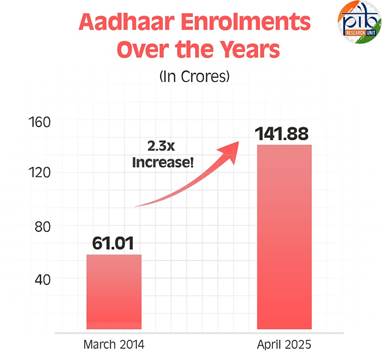
Introduced in 2009, Aadhaar has matured into the world’s largest digital identity programme. By March 2014, 61.01 crore Aadhaar numbers had been issued, a figure that rose to over 141.88 crore by the end of April 2025. So far, Aadhaar has enabled more than 150 billion authentication transactions. Its design ensures that benefits reach the intended recipients by removing duplicates and fraud.
The middle class has seen smoother access to banking, pensions, school admissions and online services, all made possible through seamless Aadhaar authentication. Its growing use reflects the public’s trust in a safe and reliable digital identity system.
DigiLocker: Documents on Demand
Launched on July 1, 2015, DigiLocker is a flagship initiative under the Digital India programme. It offers a digital document wallet that allows citizens to access, store and share authentic documents from their phones or desktops. Recognised as legally equivalent to original papers since February 2017, DigiLocker has reduced the need for carrying or submitting physical copies.
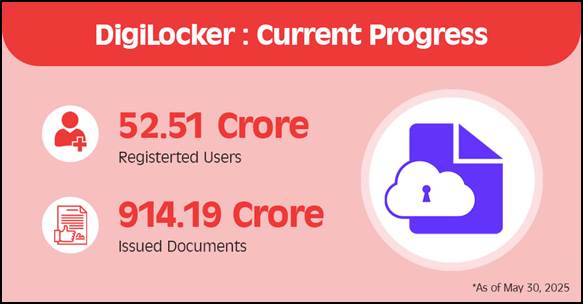
As of May 30, 2025, more than 52.51 crore users had signed up, with over 914.19 Crore documents issued by 1,936 institutions. For the middle class, this means easier access to school certificates, driving licences, PAN cards and more—anytime, anywhere.
UMANG App: All Services, One Platform
The UMANG app, launched in 2017, has made governance truly mobile. It offers a unified platform for accessing services from across Central, State and local bodies. From paying bills to booking vaccine appointments, UMANG brings government closer to citizens. What started with just 0.25 lakh users and 166 services in 2017 has now grown to over 8.19 crore users and 2,297 services across 209 departments by May 30, 2025. The app has also facilitated over 595.54 crore transactions. For the middle class, this app means fewer queues, more control and faster access to public services.
Conclusion
Over the past eleven years, the government has shown unwavering commitment to uplifting the middle class in meaningful ways. The policies and reforms introduced have not only eased everyday challenges but also strengthened financial security, housing, healthcare, and skill development. These changes reflect a clear understanding of the middle class’s vital role in India’s growth story. By focusing on fairness, simplicity, and accessibility, the government has ensured that millions of middle-income families are better equipped to face the future with confidence. This sustained and thoughtful approach has transformed lives and laid a strong foundation for continued progress.
References:
Explainer 04/ Series on 11 Years of Government
Click here for pdf file
*****
Santosh Kumar/ Sarla Meena/ Saurabh Kalia
(Backgrounder ID: 154557)
Visitor Counter : 739